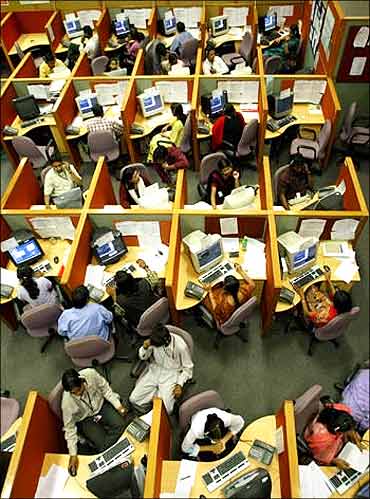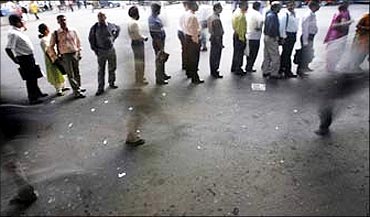 | « Back to article | Print this article |
Good news! Hiring picks up across sectors
With the economy picking up, hiring is back in full swing across sectors.
The poster boys for the information technology sector are already hiring in thousands -- both freshers from campuses, as well as experienced people (called 'laterals').
India's second-largest IT company, Infosys Technologies, for instance, has increased its overall hiring numbers for 2010-11 to 24,000.
The company said it would hire 6,000 people on a gross basis, of which 1,500-2,000 will be laterals. The company plans to make 15,000 campus offers in the next financial year, of which 9,000 offers have already been made. Click NEXT to read on further. . .
Good news! Hiring picks up across sectors
And India's largest IT company, Tata Consultancy Services, will be hiring close to 11,000 in the fourth quarter ending March 31, 2010.
Of this, close to 8,300 will come from campuses and 3,000 will be laterals. For 2010-11, the company has already made campus offers to 5,625 students.
The trend, however, is not just restricted to the IT sector. After a lull in 2009, both companies and head hunters seem more self-assured about growth, which is reflected in hiring across sectors.
Besides IT, energy, power and infrastructure, which are hiring in a big way, even business process outsourcing and fast moving consumer goods companies have entered the fray. Hiring from pharmaceuticals and healthcare segments have been steady.
"Recovery in hiring across all sectors has begun and this kind of hiring will gain momentum in the first quarter (January-March) and accelerate in April-May because March is the closing month for most Indian companies," acknowledges Sanjay Modi, Monster India MD (South-East Asia and West Asia). Click NEXT to read on further. . .
Good news! Hiring picks up across sectors
However, besides the IT and financial sectors, where commitments are being made mostly at the entry levels, other sectors are hiring at the mid- and senior-levels, especially infrastructure, power and energy sectors, according to sources.
For instance, they note, companies like Reliance Infrastructure, Gammon Infrastructure and Kalpataru Power are hiring actively. This, however, could not be independently confirmed.
"There is a cautious optimism in the job market. More activity is being observed at the senior- and mid- level management because there is a demand to fill up positions as companies look to expand slowly," says Shiv Agarwal, CEO, ABC Consultants.
Little to gain
Salary hikes, however, are not the same anymore. "In the current market, the mid- and senior-level management recruits have to do with 10-15 per cent hikes across sectors. In 2007, the minimum hikes were almost double," said Agarwal.
Some sectors, according to recruiting agencies, like infrastructure, power and energy are offering a rise of 25-30 per cent, IT is giving around 10 per cent, FMCG up to 15 per cent and BPOs, the least at 5-8 per cent. Click NEXT to read on further. . .
Good news! Hiring picks up across sectors
At the top level, popularly known as the C-level, the hikes are even lesser.
In some cases, aspirants are foregoing a hike to go to a safer company. "At this level, increments ranged between 50 and 70 per cent two years back. Now, many at the C-level are willing to take salary cuts of 15-20 per cent," says Harveen Singh Bedi, senior vice-president, Quadrangle.
Sunaina Shivnani, consultant, Stanton Chase International, adds executives at the top level are looking more at stability in the company and less at their salary levels.
"This reflects that expectations have become more realistic," added Shivnani.
But, there are small joining bonuses at the top level to sugar-coat the deal. These range between Rs 25 lakh (Rs 2.5 million) and Rs 70 lakh (Rs 7 million), according to industry sources.
Entry-level hiring has been reasonably aggressive. E Balaji, CEO, Ma Foi, says: "Banking, financial services, telecommunication, pharmaceutical and general insurance companies are looking for entry-level candidates. The pay package at this level hasn't seen any dramatic upward movement. Compared with 2007, there have been single-digit nominal increases." Click NEXT to read on further. . .
Good news! Hiring picks up across sectors
The average salaries in the Indian Institutes of Management and Indian School of Business are already at 2007-levels of Rs 12-15 lakh (Rs 1.2-1.5 million). The highest offer at ISB till date has been Rs 40 lakh (Rs 4 million), compared with Rs 43 lakh (Rs 4.3 million) in 2007.
Modi of Monster expects hiring in the IT sector to come back in cities like Bangalore. "Main metros will continue to drive growth but there will be increased momentum in the non-metros, too," he said.
Monster also expects the retail sector to bounce back and construction to be a hot one too in 2010, in terms of recruitment.
"Consolidation in construction, logistics and engineering verticals is happening. Moreover, conventional sectors like FMCG and banking have identified the rural market as the next growth market. So, a lot of hiring will happen there, too," added Modi. Click NEXT to read on further. . .
Good news! Hiring picks up across sectors
Attrition to be a problem
HR consultants are also of the opinion that, with markets opening again, attrition will again come into focus.
For instance, Infosys' attrition for the third quarter was up at 11.8 per cent from 11.6 per cent in the previous quarter. The company had an attrition of 10.8 per cent in the first quarter of this financial year.
Job portal Monster.com expects attrition to be a challenge for companies in times to come and companies to invest more on the employer brand.
The good news is that the hiring season has just begun. Industry experts are pinning their hopes on the second half of 2010-11 to see further hikes.
Additional reporting by Shivani Shinde from Mumbai and Kirtika Suneja from New Delhi.






